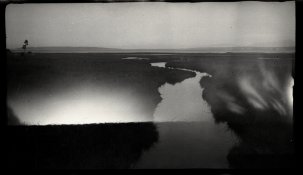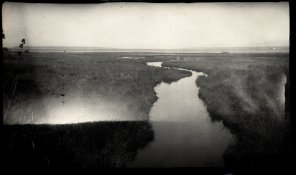I'm in the midst of an experiment here, and thought I'd ask for some input.
Two days ago I exposed a roll of film that had a develop before date of 1951, in a camera manufactured in or about 1936.
The film: more than 65 year old Kodak Verichrome (not Pan) in 616 size
The camera: an 80 year old or so Kodak Six - 16 folder.
I made a decision to meter the shots at an EI of 6. I'm trying to determine a developing time.
I intend to use HC-110 dil B.
My 1940 Kodak Reference Handbook recommends for Verichrome a time of 20 minutes in D-76, using 18C and intermittent agitation. Note however that this is for a target gamma of 0.9.
In that publication, the Sensitometric curve for the film indicates that for a target gamma of 0.6, the recommended time for Verichrome in D-76, using 18C and intermittent agitation, is 13 minutes.
Moving ahead to my 1970 issue of the Kodak Master Darkroom Dataguide, there is of course no listing there for Kodak Verichrome. There is a listing for Verichrome Pan, but the recommended development times for it in D-76 ( 8 minutes at 18C) are considerably different than either of the 1940 recommendations for Verichrome.
In more modern Kodak data sheets, the term "gamma" is replaced with "contrast index". And the recommended development times from those data sheets appear to be correlated to a target gamma of 0.6.
My plan is to develop the film in 18C HC-110 at a 1+24 dilution, using that as an equivalent to D-76.
I am thinking about developing the film for 13 minutes, with agitation for 5 seconds every 60 seconds.
This is dependent on two assumptions, which I'm asking about here:
1) the reference to "gamma" in Kodak's 1940 publication is functionally equivalent (for my current purposes) to the references to "contrast index" in later publications; and
2) the modern target contrast index of 0.6 is more appropriate for my use.
What are your thoughts about my assumptions?
I have already ruled out stand development. Do you have other suggestions?
Two days ago I exposed a roll of film that had a develop before date of 1951, in a camera manufactured in or about 1936.
The film: more than 65 year old Kodak Verichrome (not Pan) in 616 size
The camera: an 80 year old or so Kodak Six - 16 folder.
I made a decision to meter the shots at an EI of 6. I'm trying to determine a developing time.
I intend to use HC-110 dil B.
My 1940 Kodak Reference Handbook recommends for Verichrome a time of 20 minutes in D-76, using 18C and intermittent agitation. Note however that this is for a target gamma of 0.9.
In that publication, the Sensitometric curve for the film indicates that for a target gamma of 0.6, the recommended time for Verichrome in D-76, using 18C and intermittent agitation, is 13 minutes.
Moving ahead to my 1970 issue of the Kodak Master Darkroom Dataguide, there is of course no listing there for Kodak Verichrome. There is a listing for Verichrome Pan, but the recommended development times for it in D-76 ( 8 minutes at 18C) are considerably different than either of the 1940 recommendations for Verichrome.
In more modern Kodak data sheets, the term "gamma" is replaced with "contrast index". And the recommended development times from those data sheets appear to be correlated to a target gamma of 0.6.
My plan is to develop the film in 18C HC-110 at a 1+24 dilution, using that as an equivalent to D-76.
I am thinking about developing the film for 13 minutes, with agitation for 5 seconds every 60 seconds.
This is dependent on two assumptions, which I'm asking about here:
1) the reference to "gamma" in Kodak's 1940 publication is functionally equivalent (for my current purposes) to the references to "contrast index" in later publications; and
2) the modern target contrast index of 0.6 is more appropriate for my use.
What are your thoughts about my assumptions?
I have already ruled out stand development. Do you have other suggestions?
















